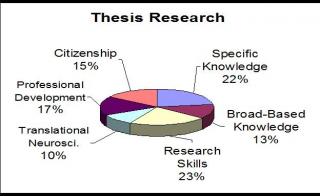|
|
Who Are We? The Neuroscience Program (NSP) is a multidisciplinary, interdepartmental graduate training program. Our objectives are: Preparation for a research career in academia, the private sector, or governmentTo
facilitate the crossing of barriers that separate academic units and,
in doing so, to facilitate the pursuit of truly interdisciplinary
neuroscience researchOur
training program incorporates coursework, independent research,
professional development training, student involvement in NSP
administration, and frequent interactions with Program and visiting
faculty speakers.
NSP degree requirements
Click to see detailed degree requirements from the NSP webpage.
NSP faculty research
Takes you to the NSP faculty listing, including biosketches.
NSP Exemplary Element Snapshot: GSC
Click to see our Snapshot describing the Graduate Student Council
(GSC), a student-organized group that facilitates interactions between
faculty and students within the NSP.
|
|
|
How Are We Accomplishing Our Goals? We
emerged from our first year of program-wide discussions with a number
of ideas on interdisciplinary research, stewardship of the discipline,
and the interaction between training goals and the training curriculum.
We are now applying these ideas internally to our training program using a three-step deliberative process (see below). These
ideas have helped reformulate our understanding of the NSP, and
consequently we are also looking for ways to frame our program externally to potential trainees and colleagues.
|
|
|
1: Identification of Core Priniciples Our first year's work revolved around identifying the 'core' principles of our training program, distilled as two questions: What is our mission as a graduate training program in neuroscience?What are the fundamental values, skills and experiences that optimize graduate training in a manner consistent with this mission?Through a series of Program-wide discussions, we distilled a mission statement.
|
|
|
|
What do we want to accomplish in the CID? Our initial CID goals were: Conduct an internal review of the training program: how are we doing now with respect to our mission/goals as set in 1999?Increase
communication within the program; find ways to build bridges across
segments of NSP that don't necessarily communicate as readily, i.e. can
we create a discussion forum where all voices can be heard?
|
|
|
Structure of the Neuroscience Program The
Neuroscience program at MSU has a long tradition of
multidisciplinary/multi-departmental interactions and collaboration
that foster a collegial, cooperative, and symbiotic environment. The
above diagram depicts the six major research interests of our faculty.
Commonalities PowerPoint
Key Ideas PowerPoint
Exemplary Element Snapshot 1
This is a link to a snapshot you can create with the Exemplary Element
Template describing an exemplary or innovative element of the doctoral
program that was instituted prior to the CID. You can share features of
the program you are proud of with others. (Delete or edit this text.)
|
|

Percentage of all respondents identifying each core competency as being a part of dissertation research.
|
2: Creation of a Diagnostic Using the principles in the mission statement as a guide, we created a diagnostic survey based on six 'core competencies'
. These competencies emerged from our Program-wide discussions as the
essential skill set that all trainees should possess when they
graduate. We then administered the survey to NSP members, asking them
which training elements provided training in each competency. We
are using the survey results to focus revision efforts towards those
elements that are not meeting student/faculty training expectations.
Description of NSP core competencies
NSP CID diagnostic survey
|
|
|
|
Other CID Work In
addition to our original CID goals, we are looking for ways to increase
awareness of the CID and of the work we are doing within the
neuroscience community: The
Graduate School at MSU has supported 3 CID student Fellowship awards
for this year (To Rob Drolet, Jim Ren and Mike Schwartz); these awards
help to support students doing CID work for the NSP. We
are meeting with other CID-participating departments at MSU to discuss
the CID and how our work is changing our respective programs.In
conjunction with several other participating programs, we have
submitted a teaching of neuroscience abstract to the 2005 meeting of
the Society for Neuroscience.
|
|
|
3: Revision of Training Elements The
first CID Innovation was the revision of our comprehensive exam format.
The new format will be administered for the first time in spring 2005,
and will be evaluated over the next several years as more student
cohorts take the exam. We
are currently involved in program-wide discussions on the teaching
requirement; for more information on the details follow the link below.Translational
neuroscience, while considered important by students and faculty, is
underrepresented in the training elements. We hope to address this in
the coming year.
|
|
|